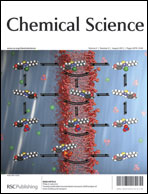Metal-organic frameworks displaying single crystal-to-single crystal transformation through postsynthetic uptake of metal clusters†
Abstract
Three metal-organic frameworks (MOFs) formulated as [Co3O(BTB)2(H2O)x(DMF)y]·zDMF·nH2O (BTB = 1,3,5-benzenetribenzoate; 1a, x = y = 1, z = 7.5, n = 12; 1b, x = 2, y = 0, z = 8.5, n = 8; 1c, x = 2, y = 1, z = 7, n = 8) have been synthesized under different temperatures; they crystallize as two-fold interpenetrated analogous structures with the same structural trinuclear Co3O(CO2)6 secondary building units (SBUs), and their stabilities depend on the temperature under which they formed. Upon immersion in the filtrate of 1a (namely 1a-s, freshly filtered) or 1b (namely 1b-s, filtered and then activated in air for three days), single crystal-to-single crystal (SCSC) transformations of 1a–1c to a new MOF, formulated as [Co6O2(OH)4(BTB)8/3(H2O)4]·14DMF·4EtOH·2H2O (2), occur along with dramatic color change from blue purple to red. Crystallographic studies reveal that the new MOF is also two-fold interpenetrated but is constructed with hexanuclear Co6O2(CO2)8 SBUs. This SCSC transformation from 1a–1c to 2 can take place only in 1a-s or 1b-s but not in 1c-s and is accompanied with an increase of metal-to-


 Please wait while we load your content...
Please wait while we load your content...